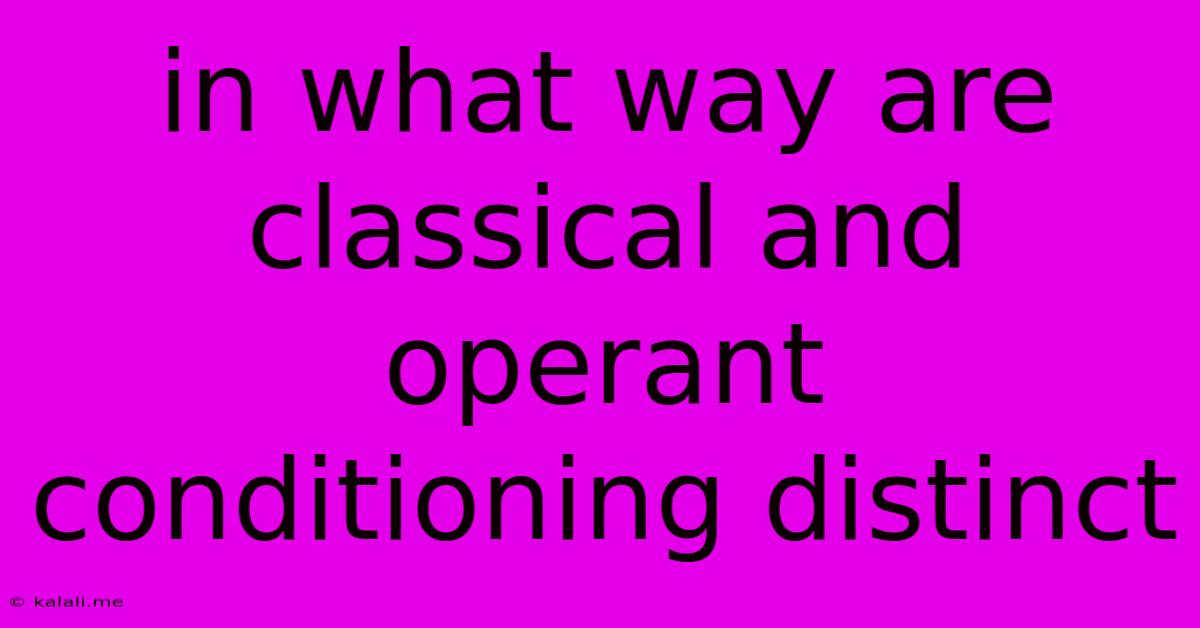In What Way Are Classical And Operant Conditioning Distinct
Kalali
Jun 15, 2025 · 3 min read

Table of Contents
Classical vs. Operant Conditioning: Key Differences and Similarities
Understanding the differences between classical and operant conditioning is crucial for anyone studying learning and behavior. While both are fundamental learning processes, they operate through distinct mechanisms and produce different outcomes. This article will explore the key distinctions between these two powerful conditioning methods, highlighting their unique characteristics and providing clear examples. This will help you understand how these principles apply to various aspects of animal and human behavior.
Classical Conditioning: A passive learning process where an association is made between a neutral stimulus and a naturally occurring stimulus. This naturally occurring stimulus triggers an automatic response. Through repeated pairings, the neutral stimulus eventually elicits the same response.
Operant Conditioning: An active learning process where an association is made between a behavior and its consequences. Behaviors followed by desirable consequences are strengthened (more likely to occur), while behaviors followed by undesirable consequences are weakened (less likely to occur).
Key Distinctions:
Here's a breakdown of the core differences between classical and operant conditioning:
1. Type of Learning:
- Classical Conditioning: Associative learning where a neutral stimulus becomes associated with a significant stimulus, leading to a conditioned response. It focuses on involuntary responses. Think of Pavlov's dogs – salivation is an involuntary reflex.
- Operant Conditioning: Associative learning where a behavior becomes associated with a consequence, leading to an increase or decrease in the likelihood of that behavior. It focuses on voluntary behaviors. A rat pressing a lever to get food is a voluntary action.
2. Role of the Learner:
- Classical Conditioning: The learner is passive. They don't actively influence the learning process; the association is formed through repeated pairings of stimuli.
- Operant Conditioning: The learner is active. They actively perform behaviors and experience the consequences, which then shape their future actions.
3. Response Type:
- Classical Conditioning: Involves reflexive, involuntary responses such as salivation, fear, or sweating. These are automatic reactions.
- Operant Conditioning: Involves voluntary, operant behaviors such as pressing a lever, speaking, or studying. These are actions the organism chooses to perform.
4. Stimulus and Response:
- Classical Conditioning: Focuses on the relationship between two stimuli: a conditioned stimulus (originally neutral) and an unconditioned stimulus (naturally eliciting a response). The response is the conditioned response, learned through association.
- Operant Conditioning: Focuses on the relationship between a behavior (response) and its consequence (stimulus). The consequence can be reinforcement (increasing behavior) or punishment (decreasing behavior).
5. Timing of Stimulus and Response:
- Classical Conditioning: The conditioned stimulus precedes the unconditioned stimulus. The timing of this pairing is crucial for learning to occur.
- Operant Conditioning: The consequence follows the behavior. The timing and consistency of the consequence significantly impacts the learning process.
Examples to Illustrate the Differences:
- Classical Conditioning: A child develops a fear of dogs (conditioned response) after being bitten by a dog (unconditioned stimulus). The dog (conditioned stimulus) now elicits fear even without a bite.
- Operant Conditioning: A child learns to clean their room (behavior) because they are rewarded with extra screen time (positive reinforcement). Conversely, a child might stop hitting their sibling (behavior) because they are put in time-out (negative punishment).
Similarities:
Despite their differences, both classical and operant conditioning share some similarities:
- Both involve associative learning, meaning learning occurs by forming associations between events.
- Both processes are involved in habit formation, shaping behaviors over time.
- Both can be used to explain a wide range of learning phenomena in both humans and animals.
In conclusion, while both classical and operant conditioning are essential learning processes, they operate through distinct mechanisms and involve different types of responses and learner participation. Understanding these distinctions is key to comprehending the complexities of learning and behavior. By recognizing the unique aspects of each, we gain a powerful framework for understanding how we and other animals learn and adapt to our environments.
Latest Posts
Latest Posts
-
A Quadrilateral With Two Lines Of Symmetry
Jun 16, 2025
-
Identify Which Of The Following Statements Is Correct
Jun 16, 2025
-
Abstract Nouns That Start With K
Jun 16, 2025
-
Average Gpa For Azusa Pacific University
Jun 16, 2025
-
Which Type Of Em Wave Has The Longest Wavelength
Jun 16, 2025
Related Post
Thank you for visiting our website which covers about In What Way Are Classical And Operant Conditioning Distinct . We hope the information provided has been useful to you. Feel free to contact us if you have any questions or need further assistance. See you next time and don't miss to bookmark.